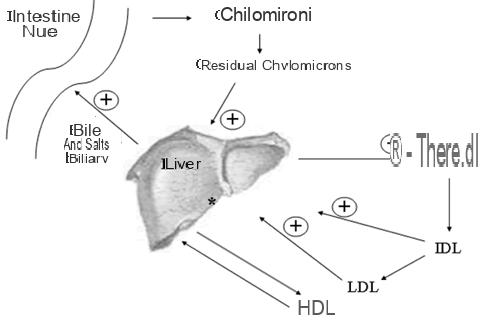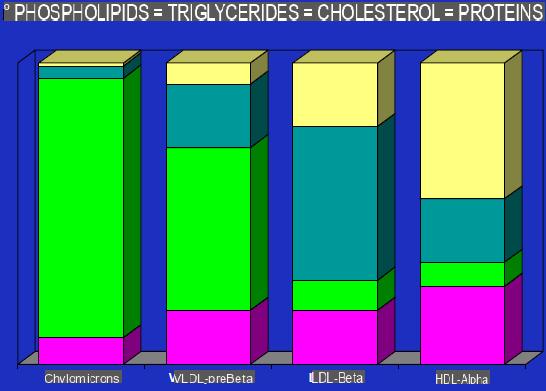What are
Lipoproteins (or lipoprotides) are macromolecules deriving from the combination of a protein with lipids of various kinds: cholesterol, cholesterol esters, phospholipids and triglycerides. Fatty substances, insoluble in an aqueous environment, can in fact be transported into the blood stream only if linked to specific lipoproteins.
Their main characteristics are shown in the following table:
Lipoproteins (or lipoprotides) are macromolecules deriving from the combination of a protein with lipids of various kinds: cholesterol, cholesterol esters, phospholipids and triglycerides. Fatty substances, insoluble in an aqueous environment, can in fact be transported into the blood stream only if linked to specific lipoproteins. Their main characteristics are shown in the following table:
| Lipoproteins * | Chylomicrons | VLDL | LDL | HDL |
| Density (g / ml) | 0.93 | 0.95 1.006 | 1.019 1.063 | 1.063 1.210 |
| Diametro Å * | 800 5000 | 300 800 | 216 | 74 100 |
Composition: protein% lipids%
|
<2 98
|
8 92
|
22 78
|
50 50
|
| Major lipid | Triglycerides | Triglycerides | Cholesterol | Cholesterol |
| Main function | Transport of exogenous triglycerides (taken with food) | Endogenous triglyceride transport (synthesized by the body) | Transport of cholesterol to peripheral tissues | Transport of cholesterol from peripheral tissues to the liver |
| Origin | Intestine | Liver | VLDL metabolism | Intestine Liver |
(*) The angstrom (Å) is a unit of length equivalent to 10−10 meters, 0.1 nanometers or 100 picometers.
In addition to these, which are the best known, there is a fifth type of plasma lipoprotein, which however does not reach significant concentrations due to its rapid turnover. These are IDLs, or intermediate-density lipoproteins, which, produced as a result of the degradation of chylomicrons and VLDLs (they therefore contain triglycerides and cholesterol in almost equal parts), are also known as "remnants", ie "remaining" from degradation of other lipoproteins.
Functions of lipoproteins
The best known lipoproteins are those of plasma, which are responsible for the transport of lipids from the intestine to the liver and from the liver to the various tissues.
|
|
KYLOMICRONES: lipoproteins consisting of a lipid heart (made up of triglycerides, phospholipids, cholesterol and fat-soluble vitamins), surrounded by protein molecules. This sort of mantle, thanks to the water solubility given to it by the proteins, increases the degree of solubility of the chylomicron in the aqueous medium. These macromolecules are produced in enterocytes (intestinal cells), from which they exit to enter the lymphatic circulation and, subsequently, the bloodstream. After distributing their lipid content to the various tissues, the chylomicrons are conveyed to the liver, which destroys their protein envelope and recycles the lipid residues contained within them.
VLDL (very low density lipoproteins) are synthesized by hepatocytes. They transport triglycerides from the liver (where they have been synthesized, for example, from glucose) to other tissues (especially adipose and muscle).
LDL (low density lipoprotein) derive from VLDL, due to progressive depletion of their triglyceride content. They are loaded with cholesterol which they transport and distribute to peripheral tissues.
HDL (high density lipoprotein) is secreted into the blood by the liver and intestines. They are therefore responsible for transporting cholesterol from peripheral tissues to the liver (they carry out the so-called reverse transport of cholesterol). |
|




























